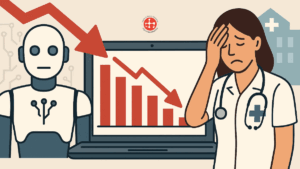In today’s digital-first world, your website is usually what your potential clients see first. A first introduction to your brand. Making it one of your most important marketing tools. We all know what they say about first impressions. You never get a second chance to make a first impression. For consumer-facing businesses, like clinics, the design, usability and content of the website are key in turning curious visitors into loyal customers.
But here’s the thing. It is not about what you or even your design agency thinks of the website. We are serious. It is purely about what your customers think. Even if you hate it. A customer-centred approach ensures that your site is visually appealing but also functional. It has to be relevant and truly aligned with user needs. Otherwise the website will not achieve it’s goals.
What is Customer-Centric Design?
A website only delivers results if it resonates with its target audience. A 2022 study on web design found that many brands make the mistake of building sites around what they want to showcase, rather than focusing on what customers want to find. A top-down approach. This method has been so prevalent in the industry that is has become a de-facto way to build websites. But as online marketing strategists put it, we need to think of each visitor individually, not as a statistic. When someone lands on your site, they should feel understood.
Effective web design begins by identifying who your customers are and understanding what they want to see. For clinics and other service-based businesses, this often means offering straightforward information about services, easy navigation and simple booking options. Studies show that design choices prioritising user needs (like prominent calls-to-action and intuitive navigation) boost engagement and drive higher conversion rates. As our own Anna Maria Balint explains, “Companies that listen to their customers’ needs grow consistently. By prioritising feedback and building loyalty, they ultimately gain a competitive advantage”.
Key Features That Matter to Users
A customer-focused website balances style with functionality, providing a seamless experience across devices. To keep users engaged and encourage them to take action, each page should offer fast load times, intuitive navigation and clear calls-to-action. According to Vervocity, a web design and marketing agency, cluttered layouts and dense text tend to push users away, while a clean layout, mobile optimisation and well-organised content build credibility and trust.
This is especially important for clinics. Users typically need quick access to clear information on services, locations and appointments. For instance, including educational resources like blog posts or FAQs can enhance credibility by positioning the clinic as a reliable source of knowledge. That is making visitors more likely to return. Turning your website into a “resource centre” with helpful content fosters long-term loyalty. Most users value accessible and expert-driven information. If they cannot access it, the conversion rate suffers.
Key Principles of Customer-Centric Web Design
| Principle | Description |
|---|---|
| Know Your User | Understand your target audience’s needs, preferences, and behaviors. |
| Clear and Concise Content | Use clear, concise language and avoid jargon. |
| Intuitive Navigation | Make it easy for users to find what they’re looking for. |
| Mobile-Friendly Design | Optimize your website for mobile devices. |
| Fast Loading Times | Ensure your website loads quickly. |
| Visually Appealing Design | Use a clean, visually appealing design. |
| Consistent User Experience | Maintain a consistent look and feel across all pages. |
| Strong Call to Action | Guide users towards desired actions (e.g., purchase, sign up). |
| Easy-to-Use Forms | Keep forms simple and avoid unnecessary fields. |
| Secure and Reliable | Protect user data and ensure website security. |
| Regular Testing and Optimization | Continuously test and improve your website based on user feedback and analytics. |
Improving Through Customer Feedback
An essential part of a customer-focused website is treating it as a constantly evolving asset. Businesses can gain valuable insights by gathering feedback through customer surveys, reviews and usage analytics. The data collected can guide ongoing improvements. As many point out, healthcare companies that adapt based on customer feedback have seen profit increases of up to 60%. This highlights the financial value of a customer-focused approach in digital strategy.
For example, a clinic in the UK might notice through analytics that visitors frequently abandon the booking page. This could indicate the need for a more streamlined booking process, live chat support, or visible testimonials to build trust. Regular updates that reflect customer needs not only improve engagement. They also show users that the brand values their experience.
Why a Customer-Centric Website Matters for Clinics
For medical clinics and any consumer-oriented enterprise, an appealingly designed customer-oriented website is more than essential. It is critical. A well-designed and user-focused site can make services easier to access, help patients build trust and build brand reputation. When visitors can take their next step confidently and quickly, the website serves as a powerful vehicle for growth and engagement. The ability to convert first-time visitors into loyal customers through an enriching online experience that puts their needs first, is the key to a successful online business.
In the end, it is the customers perspective that matters most. In today’s digital landscape, businesses that do not align their online presence with user expectations risk losing customers to competitors who do.










